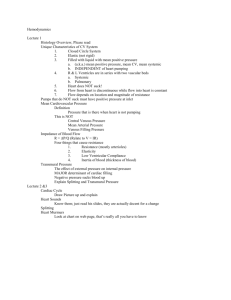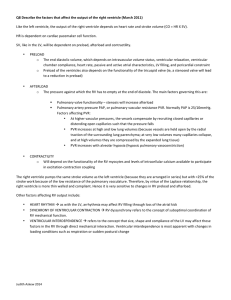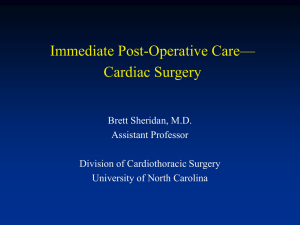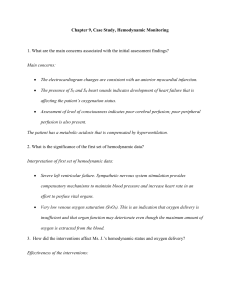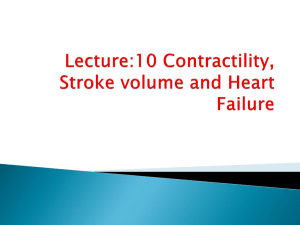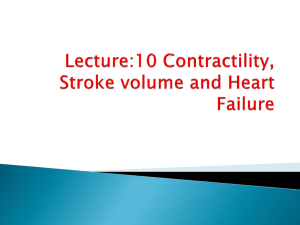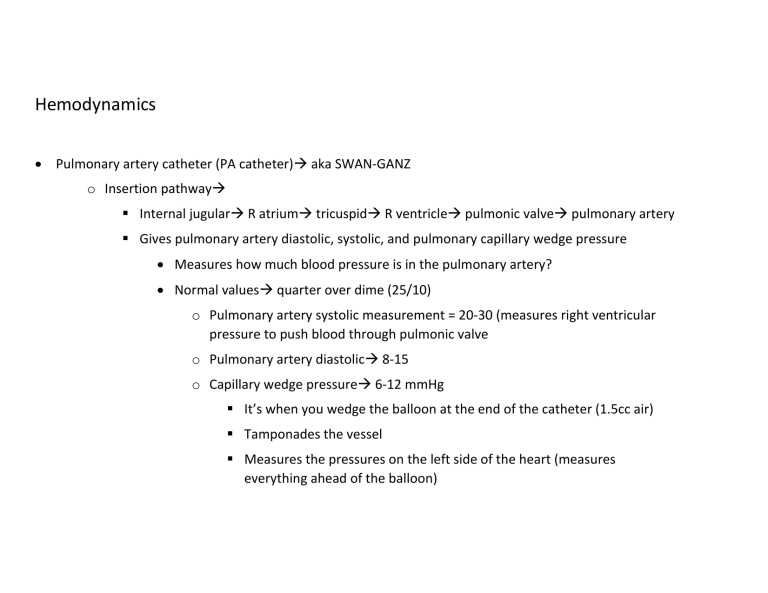
Hemodynamics Pulmonary artery catheter (PA catheter) aka SWAN-GANZ o Insertion pathway Internal jugular R atrium tricuspid R ventricle pulmonic valve pulmonary artery Gives pulmonary artery diastolic, systolic, and pulmonary capillary wedge pressure Measures how much blood pressure is in the pulmonary artery? Normal values quarter over dime (25/10) o Pulmonary artery systolic measurement = 20-30 (measures right ventricular pressure to push blood through pulmonic valve o Pulmonary artery diastolic 8-15 o Capillary wedge pressure 6-12 mmHg It’s when you wedge the balloon at the end of the catheter (1.5cc air) Tamponades the vessel Measures the pressures on the left side of the heart (measures everything ahead of the balloon) Measures central venous pressures (right atrial pressures) 2-6mmHg (below normal = low intravascular volume) When placing the Swan Ganz o Place patient in Trendelenburg o Do it quickly too long can lead to lung infarction Adverse effects of Swan Ganz o Arrhythmias o Pneumothorax o Balloon rupturing o Heart blocks o Lung infarction o thrombosis o Air embolism o Ventricular turbulence –> can lead to naughting in catheter o Valve damage o Infection A-Line (arterial line) o Get an A line in hypotensive patients 2 o Sites radial brachial, and femoral arteries [umbilical for neonates] o For direct, continuous bp measurement; blood sampling access, particularly ABG’s Distal BP has larger margin for error Newer A-lines calculate stroke volume and continuous CO o Measures relative to atmospheric pressure SBP, DBP, MAP (MAP is most accurate) MAP >60 mandatory to maintain minimul perfusion of vital organs May be up to 10-15 mmHg > cuff pressure o Components Transducer make sure it’s leveled at 0 pressure; have it at the flevostatic access (lines up with R atrium) Make sure it’s leveled and zeroed before procedures o Safety: Clench fist a couple times Look for blanched palm Occlude ulnar artery and radial artery Look at Allen’s test 3 o It should be sutured in or will have a stat lock (specific to arterial lines) A-line NEEDS to be secured into place o Pressure bag in place infusion of NS @ 3ml/hr DO NOT INTERRUPT this line ever! o Prevent air from entering the line do not disconnect A-line ever o Check for distal circulation and possible thrombosis; change site every 72/96 hrs o Prevent line separation and arterial hemorrhage o Use sterile technique to prevent local and systemic infection/sepsis o After removal, hold continuous pressure for at least 10 minutes if no bleeding, apply a pressure dressing Insertion of central/a-lines o Pt laid supine during insertion to minimize the possibility of air embolism o Pt laid supine while removed o Lidocaine is injected at the site pain coverage o Site prepped like a surgical site to prevent infection at site and systemically o If pt conscious turn head to opposite side from insertion and breathe out during insertion (minimize possibility of air embolism; better access) o Physician typically allows blood to flow from the catheter after insertion (minimize possibility of clot and air embolism) 4 o Then suture into place by MD and applies sterile dressing The nurse Secures all tapes and connections DO NOT INFUSE ANYTHING UNTIL CONFIRMATORY X-RAY of chest to confirm placement Any signs of air embolism or pneumothorax after procedure o Check lung sounds and for dyspnea (pneumothorax and air embolism to lung?) o Checks for decreased LOC (air embolism to the brain) Check CXR check for placement and pneumothorax PICC line o Maintain sterility o Change dressing per hospital policy o Measurement for swelling o Measure external length o Sign over the bed no blood draws or BP on that side! Hemodynamic monitoring o Non-invasive BP, HR, P 5 Mental Status Skin temp, cap refill Urinary output o Direct measurement A-line Titration of gtts Unstable BP Frequent ABGs/lab monitoring o Invasive monitoring: CVP, PA o Indications Dehyradration/ hemorrhage/ GI bleeds/ burns Surgery Shock (all types): septic, cardiogenic, neurogenic, anaphylactic shock Acute MI/cardiomyopathy/ decompensated HF Cardiac performance PRELOAD o Stretch created by volume in the ventricles just before they contract Volume in the ventricles at the end of diastole (filling pressure) o The volume of blood ejected with each beat is a stroke volume (SV) 6 o Preload is the most important factor determining SV CO o Effects instantaneous and beat to beat Frank-Starling Law of the Heart o As end-diastolic volume (EDV) is increased, the stroke volume is increased o Strength of ventricular contraction varies directly with EDV Intrinsic properties of myocardium As EDV increased, myocardium is stretched more Greater contraction and SV Factors affecting preload o Circulating blood volume o Venous return Atrial kick Filling time Intrathoracic pressure Vascular tone (“squeeze” factor) Ventricular compliance Contractility o Measurement: central venous pressure 7 AFTERLOAD o Resistance against which the ventricles must pump to eject the volume (systemic vascular resistance SVR) (800/1400 d/sec) o Aka resistance to flow or “clamped” blood vessels o This resistance is created by vasodilation/vasoconstriction of systemic arteries and arterioles Factors affecting afterload o Valve function o Vascular tone Vascular health/condition ANS (neurohormonal stimulation) Medications Pulmonary vascular resistance (PVR) o Pulmonary hypertension o COPD o Pulmonary embolism o Acidosis (pulmonary vasoconstriction) o Hypoxemia o Drugs 8 Systemic vascular resistance (SVR) o Arterial resistance (vasoconstriction, SNS stimulation, aortic impedance-aortic stenosis) o Cardiac failure o Increased blood viscosity o Pain/anxiety o Hemorrhage (early) o Drugs o Distributive shocks Agents that affect afterload o To decrease afterload Vasodilators nipride, nitro Ace inhibitors o To increase afterload Vasoconstrictors norepi, epi, phenylephrine, dopamine Contractility o Force of muscular contraction inotropy o Factors affecting contractility 9 Positive inotropes: dopamine (pure CO med); Digoxin (improve contractility but decreases HR) Negative inotropes: beta blockers Pre-load Afterload Muscular ability Viable muscle mass Oxygen supply/demand Myocardial metabolic state Neurohormonal influence Contractility o Direct measurement of ejection fraction (EF) Percentage of blood ejected from left ventricle with each contraction The ratio of how much blood ejected to the volume at the end of diastole (left ventricular end-diastolic volume) Determined by echocardiogram or during left heart catheterization Normal Effects of afterload on the heart 10 o Factor increased afterload Causes Hypovolemia Vasoconstriction Effects on heart Decreases stroke volume Increases ventricular work Increases myocardial oxygen requirements Increases stroke volume o Factors decreased afterload Causes Vasodilation Effects on heart Decreases ventricular work Decreases myocardial oxygen requirements Cardiac output o The amount of blood ejected from the left ventricle in one minute 11 o CO = HR x SV o Determined by volume returning to left heart (preload), SVR (afterload), and contractility Cardiac index cardiac output factoring patient’s surface body area 12 13 Hypovolemic Cardiogenic CO/CI (sv x hr) CO 4-6 L/min CI 2.5 – 4.0 L/min Preload stretch/fluid status CVP/RAP 2-6 mmHg Afterload resistance SVR 800-1400 Dynes/sec PVR <350 Dynes/sec Contractility squeeze/contractions EF 60% HR 60-100 Decreased loss of fluid Decreased broken pump Decreased primary problem Increased compensatory mechanism Increase backed up fluids Decrease primary problem Increased compensatory mechanism Decreased primary problem Neutral Decreased primary problem Pump is broken Increased compensatory mechanism Increased compensatory mechanism Treatment Fluids O2 Stop the loss Increased- compensatory mechanism Diuresis decrease preload O2 ACE inhibitors (block angiotensin 2) Decrease afterload IABP intra-aortic balloon pump Distributive (massive vasodilation; body fluids are displaced) Anaphylactic, neurogenic, septic Increased compensatory mechanism Increased compensatory mechanism NEUROGENIC SHOCK bradycardia is the hallmark rhythm Fluid resuscitation Vasopressors O2 Treat the cause Septic shock draw blood cultures, draw labs and lactates, give broad-spectrum abx 14
